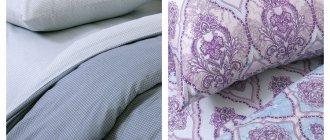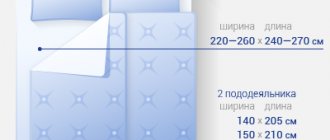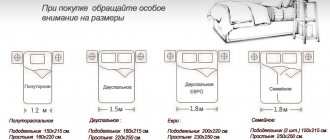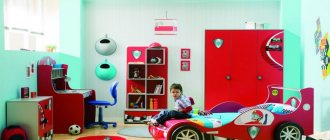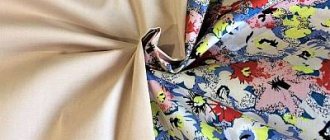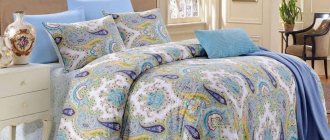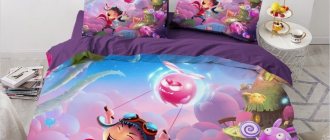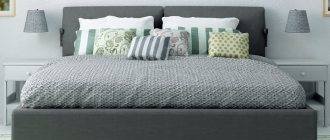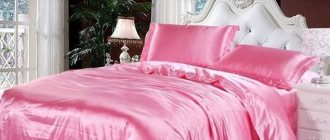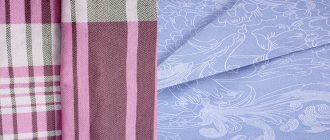Characteristics of children's fabrics
To arrange a children's bed, you should select high-quality materials. They must meet basic requirements.
- Be safe for the baby. Bedding should not emit harmful substances that can lead to dermatitis, allergic rashes, itchy skin and other problems. In the manufacture of such materials, chemically “aggressive” dyes should not be used.
- Possess hygroscopicity. Children often sweat during night or daytime sleep, so bedding fabric should absorb excess moisture well and dry quickly.
- Good air flow. Natural circulation will allow the skin to “breathe”, thereby creating favorable conditions for quality rest.
- Contribute to the absence of static accumulation.
- Differ in color fastness. Sometimes it happens that patterns from colorful and bright fabrics remain on the child’s skin after sleep. This shouldn't happen.
- Be comfortable. The bedding material should create a pleasant tactile sensation when in contact with the body.
- Have sufficient strength and wear resistance. The fact is that bedding in a child’s crib gets dirty much more often than in an adult’s. Therefore, it is important that the material can withstand more than a dozen washes while maintaining its original qualities.
- Easy to care for. This is an optional criterion. However, any parent will appreciate it if the fabric is easy to wash, dry quickly and smooth out without much effort.
An important selection criterion is the appearance of the fabric. Before falling asleep, many children look at the pictures on the duvet cover, pillowcase or sheet. Therefore, images on bedding should be unobtrusive, but attractive to children.
Filler
Fillings for bed linen can be divided into two groups: natural and synthetic. Both of them are used only of high quality and meet all hygienic standards.
Without a doubt, natural materials are always better and preferable to artificial ones.
They have antibacterial properties, hygroscopic, breathable, and provide good thermal insulation. They are soft and light, warm and pleasant.
Italian manufacturers are distinguished by high quality. But to buy bed linen from Italy, you don’t have to go there.
Choosing a sheet
A sheet is a rectangular piece of fabric that covers a mattress. This type of textile wears out quite quickly because it experiences more friction and withstands pressure. The sheet most often needs to be washed.
There are several types of sheets:
- An ordinary piece of fabric, processed on all four sides, is simply used to cover the mattress. It’s good if this item is larger than the size of the bed, so that all the edges can be tucked under the mattress - this way the sheet will hold well and will not bunch up or slide off.
- A sheet with an elastic band is ideal for a child's room. The product is very easy to attach to the bed thanks to the elastic tape that is sewn around the perimeter. The elastic prevents the sheet from coming off, and the child sleeps peacefully.
- A Velcro sheet is also a good option for a child's bed. However, be careful - Velcro clings to all fabrics during washing, but they perform their function - to stay on the bed - perfectly.
Standard bed sheet sizes:
- 110x150 cm (nursery bed);
- 120x150 cm (standard);
- 150x220 cm (schoolchildren and teenagers).
Sometimes fabrics for children's underwear are treated with special impregnations. If necessary, you can find not only antibacterial kits, but also products with waterproof treatment.
Features of the cut
The seams of children's bedding should not irritate the skin. Therefore, if they are in places of contact with the child’s skin, let them be completely flat. But it is much better if there are none at all.
Babies can be very active in their sleep, especially when they have just learned to roll over and crawl - sometimes in the morning you can see that the sheet is crumpled. Therefore, for babies, manufacturers make sheets with elastic bands - they are much easier to put on, they will always remain in place.
If your set includes a duvet cover, it may have a hidden zipper or no zipper at all. But in the second case, the hole should be such that the blanket does not fall out, and located so that the child cannot get entangled in it.
Colors
When choosing a set of bed linen or fabric for a duvet cover, pillowcase or sheet, you should consider its color. Scientists have long proven that colors can influence a child’s psyche, mood and behavior.
When purchasing fabric for a baby's crib, it is better to choose products in soft pastel colors. White and milky shades will help calm and relax the child, ensuring that he quickly goes to sleep. Pale blue, soft pink and beige tones of bed linen will also “help you sleep.” It is important to note that the accessories should not have numerous bright images. It is better that the number of pictures is limited and their colors are light.
Bright colors such as green, red, orange, blue can energize children and give them energy. Due to these features, bedding with such shades is recommended for use in the beds of children who are already beginning to show interest in games.
When choosing fabric for a children's sleeping set, you should avoid purchasing materials in dark colors. Blue, black, purple, dark brown colors will cause a child to feel anxious.
Bed linen of such colors will not allow the baby to relax and fall asleep quickly.
Color spectrum
Which bedding is better for children: white or colored? The safest option is a plain white or unbleached fabric. If there is a pattern on the sheets and duvet cover, especially a contrasting one, it should not change color or fade. Since this is a sign of poor-quality paint, it is not advisable for either a child or an adult to sleep on such linen.
If you decide to choose colored fabric or a set with patterns, then pay attention to the products of well-known manufacturers who use safe paints. These sets have a wide range of designs - you can choose sets with stylish colored sheets and matching patterns, or patterns on the duvet cover. Some sets include bed rails: in addition to their decorative function, they also protect the baby from bright light and drafts.
When choosing colored underwear, be guided by your preferences and how your baby behaves, at least until he learns to indicate his preferences. Blue color calms and harmonizes, green - relaxes, orange and yellow helps increase concentration, red gives vigor. Diluted pastel shades are more suitable for sleep than pure colors. It should also be remembered that young children are attracted to contrasting colors, and therefore it is better to leave them for toys and clothes.
Pillowcase for healthy sleep
The pillowcase should be chosen carefully so that it does not compress or deform the pillow.
Choosing the perfect pillow for your baby is not easy. The pillowcase should adequately complement the bedding, protect the product, be pleasant when in contact with the skin of the face, be easy to wash, and also have a comfortable design. It is important that the pillowcase can be easily removed and put on. High-quality material does not fade, absorbs moisture well, allows air to pass through and does not allow the filler to break through the weave of the threads.
Types of children's pillowcases:
- with a smell (most often found among standard ready-made kits);
- in Oxford style (with “ears”, that is, with textile fringe);
- with a zipper (a very durable and reliable way to hold the pillow inside the pillowcase);
- on buttons and buttons (the design is very good, but the zipper can be closed in one movement, but the buttons and buttons will have to be carefully fastened one after another).
When purchasing, make sure that all accessories are safe, that the buttons hold well, and that the metal zipper will not scratch you. If you are worried, feel free to purchase a regular scented pillowcase - this is an absolutely safe product.
Standard children's pillowcases come in two types: square and round. Main dimensions:
- 40x60 cm;
- 35x45 cm (Euro size);
- 70x70;
- 50x70.
When purchasing a set of bed linen, make sure that all the fittings work, all machine stitches are straight, and the product itself does not have a chemical smell. Under no circumstances should traces of dye remain on your hands - you should absolutely not buy such underwear.
Correct head position during sleep is very important for health. A comfortable posture, relaxed muscles - all this prevents the development of various diseases. Choose your pillowcase carefully so that it does not compress or deform the pillow due to the wrong size.
This is interesting: Children's pillows: for sleeping, orthopedic. Which ones to choose and buy?
About duvet covers
It is recommended to give preference to duvet covers with zippers or buttons.
Long gone are the days when you had to wrap your blanket in duvet covers with an awkward hole in the front. The blanket crumpled, fell off, and tore out. Modern children's duvet covers are a more reliable design that closes and does not allow the product to fidget inside the cover. Options with a slot in the center can still be found on sale, but the side hole is considered the most reliable.
The following types of duvet covers are recommended for a children's room:
- With a zipper - the product can be easily and quickly changed, the slot closes securely in one movement.
- It has snap buttons, just like the zipper, it is a quick and easy fastener. However, at home it can be difficult to replace.
- The button-down is a timeless classic. To fasten the duvet cover, some movements will be required, but if it breaks, the entire structure can be replaced without going to a repairman.
Standard sizes:
- 110x140 cm;
- 140x205 cm.
When choosing a duvet cover, it is enough to know the size of the duvet. It is best if the textile exceeds the size of the blanket by literally 5 cm, no more. The duvet cover will not fit in a duvet cover that is too small, and a duvet cover that is too large will warp and shift.
Review of textiles for bedding sets
Fabrics for sewing children's underwear must strictly meet the following requirements:
- high level of hygiene;
- hypoallergenic;
- breathability;
- hygroscopicity;
- smoothness and softness;
- wear resistance and durability;
- practicality and ease of care;
- color fastness.
Basically, natural fabrics meet all these qualities. However, almost all natural materials have some drawback - they either wrinkle, are short-lived, or are expensive. That is why a small amount of synthetics is added to many materials, even for children's clothes.
Most often it is polyester, which is made to look like almost any fabric. If the scary word “polyester” is still found in the composition, you shouldn’t be scared at all - a bit of synthetics reduces the price of the product and does not allow it to wrinkle. In any case, carefully review the labels before purchasing.
Natural materials for making fabrics:
- cotton is a fiber of plant origin, light and safe;
- linen is also a plant fiber, delicate and breathable, but wrinkles a lot;
- bamboo is a relatively new material of natural plant origin, very pleasant to the touch and environmentally friendly;
- silk is a protein fiber, incredibly smooth and beautiful, but very expensive.
The following fabrics are made from these materials, either in pure form or in combination, suitable for sewing children's sleeping sets:
- Calico is a dense, reliable, affordable cotton fabric. It is made by perpendicular weaving of threads (plain). Traditional material for making bed linen and other types of home textiles. Made entirely from natural raw materials, suitable for children's rooms.
- Percale is a very durable fabric; to create it, use thin and medium threads that are not pre-twisted. This is a truly unpretentious material - at the dawn of aviation, it was used to make skins for aircraft. Percale can withstand a huge number of washes, while it is quite pleasant to the touch.
- Polycotton is a blend of cotton and polyester. Thanks to natural raw materials, the fabric is light, soft, breathable, and absorbs moisture. Polyester does not allow the fabric to wrinkle and makes products more durable. The price of the fabric is affordable, they produce products with bright, pleasant patterns.
- Ranfors is an improved version of calico. The fabric was invented in Turkey. Cotton fibers are very carefully processed, spun and polished. Ranfors differs from calico by its increased density, which allows the fabric to be particularly smooth.
- Satin is a beautiful, smooth fabric. It is mainly made from silk, but there are more affordable models made from cotton. The material owes its glossy shine and extreme tactile pleasantness to the dense satin weave on the front side.
- Chintz is a very light, often brightly colored cotton fabric. The material is ideal for sewing summer sets; it will not be too heavy for a child.
All these fabrics are produced mainly on a cotton basis. They are universal and safe. Cotton holds color well, so there will be no difficulty in choosing a bright set that your child will like and decorate the room.
TOP 9 quality bedding for children
ArtBed
An exclusive approach to design and in-house fabrics contribute to the popularity of the brand. As a material, the manufacturer gives preference to safe, durable fabric that does not fade and is pleasant to the body, mainly calico, satin, poplin. The company has repeatedly become a prize-winner and laureate of various competitions.
Interesting: TOP 10 best feeding bottles
Advantages:
- High quality fabrics;
- Safe paints;
- Certified products;
- High-quality tailoring;
- Smooth seam;
- Doesn't sit down;
- Easy to care for;
- Affordable price range;
- Does not fade;
- Wear resistance;
- Good feedback.
Flaws:
- Not detected.
Children's bedding ArtPostel
Fidget
High-quality bed linen for children made of 100% cotton. Children are delighted with the trendy designs and drawings with the most famous cartoon characters. Some types of kits glow in the dark, the seams are made with high quality and do not injure the delicate baby skin. Fabrics used: poplin, calico, cotton - 100%.
Advantages:
- Does not shed;
- Does not deform;
- Positive reviews;
- Quality of tailoring;
- Bright drawings;
- Strength;
- Seam quality;
- Wear-resistant;
- Original, luminous models;
- Wide choose.
Flaws:
- Price.
Children's bedding Fidget
Letto
High-quality, safe and bright children's bedding, to the delight of parents and children. High quality tailoring and natural raw materials make the products relevant, which is why they are in great demand. Basically, all children's sets are made of satin, which is famous for its durability, practicality and softness, as well as tightly woven calico. The kits retain their original appearance for a long time, thanks to the stable, safe dye.
Advantages:
- Quality of tailoring;
- Safety;
- Wear-resistant;
- Does not shed;
- Does not shrink after washing;
- Children like it;
- Bright and beautiful drawings;
- Soft;
- Natural cotton;
- Strength;
- Value for money;
- Wide choose.
Flaws:
- Sometimes there are small imperfections;
- Requires special care.
Children's bedding Letto
Valtery
Natural cotton products, safe for little ones. The standard set includes 4 zippered sides for the crib. The raw materials used are: percale, poplin, satin, as well as polycotton (a mixture of cotton and polyester, characterized by minimal accumulation of static electricity. Pictures on bed linen come in both bright and delicate colors. High-quality digital printing does not fade, maintaining its original appearance for a long time. Natural Cotton absorbs moisture, retains heat well and allows the skin to breathe.
Interesting: Top 8 best children's clothing brands, what is a good manufacturer of children's clothing?
Advantages:
- Harmonious drawings;
- Equipment;
- Price;
- Durable paints;
- Wear resistance;
- Wide choose;
- Modern design;
- Children like it;
- Easy;
- Hypoallergenic;
- Does not shed;
- Thematic variety.
Flaws:
- No reviews.
Valtery children's bedding
Blakit
Children's bedding meets the most stringent quality standards and is absolutely environmentally friendly, natural, and therefore hypoallergenic. The sets are hygroscopic; they tend to absorb moisture, preventing its accumulation. The high density of fabrics will allow you to maintain its original appearance for a long time. The materials used are poplin, calico, and have a soft and pleasant structure. Pictures are applied using digital printing, which reveals the detail of the picture. The dyes are also environmentally friendly and hypoallergenic.
Advantages:
- Stable color;
- Natural material;
- Hypoallergenic;
- Hygroscopicity;
- Easy to care for;
- Wide choose;
- Stylish design;
- Pleasant to the body;
- Air permeability;
- Gifts and promotions from the manufacturer;
- Value for money;
- Natural, hypoallergenic dyes;
- Positive feedback from parents;
- Bright drawings.
Flaws:
- No.
Children's bedding Blakit
Vasilisa
Kits chosen by caring mothers. Good, high-quality and safe bedding for children, with bright prints, as well as calm, plain ones. The following materials are used for children's bedding: calico, poplin, linen. For newborns, linen products are intended that are certified by OEKO-TECH, indicating the absence of harmful substances. The brand has been repeatedly awarded with various awards and quality marks. Special attention is paid to children's textiles, which is why mothers choose the Vasilisa brand.
Advantages:
- Hypoallergenic;
- Easy to care for;
- Eco product;
- Original design;
- Natural material;
- Affordable prices;
- Antiseptic actions;
- Trusted manufacturer;
- Hygroscopicity;
- Wide choose;
- Soft surface;
- Strength;
- Wear resistance.
Flaws:
- No.
Children's bedding Vasilisa
3. Amarobaby
Domestic products undergo more than one stage of quality control. A relatively young company uses exclusively high-quality materials and introduces innovative technologies into the production process. The product design was developed jointly with Italian technologists. So, on natural hypoallergenic cotton, cute animals, owls, cats, giraffes, pandas, etc. are depicted.
Advantages:
- Current colors;
- Wear-resistant;
- Quality materials;
- Price;
- Does not shed;
- Good feedback;
- Good assortment;
- Innovative technologies are being introduced.
Flaws:
- No.
Children's bedding Amarobaby
Perina
Thanks to the exclusive design and original design, the manufacturer’s products can be safely chosen for fashionable princesses. To create children's sets of increased comfort, innovative technologies are introduced and safe materials are used. The materials used, premium satin with silk effect and satin, are particularly durable, at the same time smooth, pleasant effect. Bed linen made of natural cotton allows air to pass through well and maintains a comfortable temperature. The reactive method of dyeing fabric allows you to maintain its brightness and original appearance after repeated washings. In addition to standard bedding sets, the manufacturer offers an enlarged one, which includes: a pillowcase and a blanket, a soft bumper for the crib and a canopy.
Interesting: Top 9 best video nannies
Advantages:
- Exclusive design;
- No pellets are formed;
- Variations of the enlarged set;
- Fashionable designs and colors;
- Use of innovative technologies;
- Price;
- Official guarantee;
- Environmental materials;
- Strength and durability;
- Ease of use;
- Good assortment;
- Wear resistance.
Flaws:
- Not detected.
Children's bedding Perina
What else might you need for a crib:
Mattresses
to the store It is important that the mattress fits the size of the crib. Its main indicator is density and hardness. Newborn babies need a firm mattress that will promote the proper development of the musculoskeletal system.
Baby powder
to the store To wash children's clothes, you should use baby powder. It does not contain harmful substances and is gentle on the fabric. It doesn’t matter whether you wash in a machine or by hand - baby powder will carefully clean your laundry from dust and dirt.
Sides
to the store Sides have several purposes. In addition to the fact that they protect the child from impacts on the bed frame and from drafts, such a bumper creates a feeling of protection and privacy, like in the womb. Therefore, in the first months it is indispensable.
Diapers
to the store At first, diapers are an irreplaceable thing. even if you don't swaddle your baby. They are used as a support during trips to the doctor, in the summer they cover the child in the stroller, and also cover themselves during feeding.
To the begining
How to care for your laundry
- Washing in manual and automatic modes must be carried out in accordance with temperature requirements. This promotes long-term use of the laundry. When exposed to high temperatures, the fibers become thinner and quickly break. The same goes for ironing. Ironing clothes too often at high temperatures wears out the fabric.
- You need to change your underwear at least once a week, or even more often. Unwashed laundry, even if it is not soiled, is a source of allergens. Keep this in mind when choosing the number of bedding sets. 3-4 sets will be just right.
- Periodically deep clean the mattress: ventilate it, beat it, or take it to the dry cleaner.
- You don’t have to buy linen as a set; you can buy sheets, pillowcases and duvet covers separately. The main thing is that it is all the same size as the mattress, pillow and blanket.
- A pillow for a newborn is an optional accessory. It can be replaced with a sheet or diaper folded several times.
Basic requirements for children's bedding
In accordance with sanitary standards, bedding for children must be made from natural fabrics.
There are strict requirements for the material:
- Environmental Safety. The presence of allergens and toxins in the material that cause itching and irritation on the child’s skin is not allowed.
- Breathability. The ability of the material to allow air to pass through allows the baby’s skin to “breathe.”
- Hydroscopicity. The child will not feel discomfort if he sweats or if a little childhood accident happens to him. Material that can absorb and retain moisture will provide your baby with a comfortable sleep.
- Wear resistance. The fabric must withstand repeated washing without deforming and maintaining its strength.
- Color fastness. High-quality material is characterized by maintaining the brightness of colors even after numerous washes. In this case, the paint should not remain on the baby’s skin.
- Heat dissipation. Bed linen made of fabric with good heat dissipation will give your baby coolness on hot days and warmth in the cold season.
- Easy to care for. Ease of washing and subsequent ironing will save parents from unnecessary hassle.
Also, natural fabrics have their own characteristics, that is, they wrinkle easily and shrink after the first wash.
In addition to the listed properties of the material, its attractiveness remains an important criterion when choosing bed linen. Calm colors and unobtrusive patterns contribute to the pleasant lulling of the baby.
Lingerie you shouldn't buy
Sometimes buyers are interested in what the cheapest kits are. It is absolutely clear that only synthetic fabrics are used for cheap underwear. These sets are very popular with conductors of budget carriages and owners of cheap hotels. Synthetics are easy to wash; you can simply soak them in cool water, rinse them and give them to the next guest or passenger. Workers of public organizations purchase sets of soft colors, knowing that such material fades very much.
Most often, the cheapest synthetic underwear is made from polyester. Before making your bed, read what is written on the packaging. Synthetics are mainly made from petroleum products. It does not absorb moisture and does not hold dyes. You can buy a set of very beautiful colors, but all night you will suffer from stuffiness and puddles of sweat, and in the morning you will spend a long time and unsuccessfully trying to wash off the prints that have transferred to your body from the fabric. If you want to get a free tattoo for a few days, buy cheap bed linen at the market.
If you've spent just one night in a carriage and the next day your whole body itches terribly, you know that you've been put on synthetic sheets. Often such sets are given to employees by the owners of small companies. At a New Year's corporate party, did Santa Claus take out a bag and hand you a set of bed linen? Do not rush to lay it on the bed, first carefully read the composition of the fabric. If there are more than 50% synthetic fibers, it is better to get rid of such a gift. Homeless people who often sleep on newspapers can rejoice at such a luxurious gift, but decent people are unlikely to want to sleep on waterproof synthetics and wake up with their bodies covered with patterns of flowers and leaves.
Unscrupulous manufacturers often hide the composition of the fibers, and the buyer cannot always understand what material the set is made of. Read all information on the packaging carefully, especially those written in small, dull letters. A large bright inscription “cotton” catches your eye, but if you look closely, next to it is written “polyester 50%” in an inconspicuous font. It is advisable not to buy products that contain difficult-to-read inscriptions at all. A good company does not hide any information, it writes everything clearly and clearly, and you will immediately understand what kind of bed fabric was used.
Care
A child is often an active and cheerful person. The baby plays on the bed, builds houses from blankets and pillows. This is why bedding needs to be washed frequently to keep it clean and hygienic. The fabrics are completely different, plus the dye and various fasteners. The manufacturer always writes in detail about all the nuances on the label. However, for any children's bedding it would be useful to follow the following rules:
- wash by hand or in a machine at water temperatures up to 40 degrees;
- do not bleach or use aggressive chemicals;
- iron at moderate temperature;
- dry the products outside, in the shade, on the balcony or in a well-ventilated room;
- You can also use a dryer.
Beautiful, soft and smooth bedding will help teach your child to follow a daily routine. There are many standard sets that can be purchased if you know the sizes of pillows and blankets. When choosing a set for a children's room, take into account the influence of color on the child's psyche, select a suitable fabric, and make sure the quality of the textiles. Wash the products regularly, use gentle products, study the instructions on the label - following these simple rules will allow you to use the set for a long time and maintain its attractive appearance.
Material requirements
Fabric for sewing children's bedding is selected according to the following important criteria:
- hypoallergenic. Allergies can be triggered by synthetic fibers that make up the fabric, or by the dyes used to dye the material. It is better to give preference to natural materials with muted shades;
- environmental friendliness. The fabric should not contain components that have a toxic effect on the body;
- breathability. Materials that allow air to pass through are often called “breathable.” Such a bed will not create a sauna effect, which means the child will not sweat excessively;
- comfort. The fabric should be pleasant to the touch, but at the same time durable enough.
In addition, the fabric for children's bedding should be highly wear-resistant and also easy to care for. This material will easily withstand numerous washes without losing its shape or color.
Psychology of shades of color
Warm colors
In general, warm colors evoke joy and comfort, creating a cozy feeling even in large open spaces. Bold shades of red, orange and yellow stimulate the mind and have an energizing effect on the body as a whole. Warm tones, while beneficial for growth and development, are not so beneficial when it comes to nighttime sleep; you must admit that it is quite difficult to put an overly energetic baby to bed quickly. Thus, red, yellow and orange colors are best used in moderation, or use warm tones along with cool tones to create a sense of balance.
Red
Highly emotional - red excites and energizes the body, increasing heart rate, blood pressure and breathing. Some studies show that red increases athletic ability. However, the color red increases aggression, inability to concentrate and can even cause headaches in a child.
Pink
Little girls' favorite color. Evokes feelings of empathy, imparts femininity and creates a calming atmosphere. However, despite the initial calming effect, pink can become irritating after a long time.
Yellow
Bright and cheerful yellow is associated with happiness. Soft, tranquil yellow promotes concentration, while brighter shades can stimulate memory and improve metabolism. At the same time, excessive use of yellow can cause feelings of disappointment.
Orange
Friendly and welcoming, orange has a distinctly social character, inspiring interpersonal communication and communication skills.
Cool shades
Cool colors have a calming and relaxing effect on the body, creating a feeling of spaciousness, as well as restraint.
Blue
The exact opposite of red. Blue calms the mind and body, lowers blood pressure, heart rate and breathing, reducing anxiety and aggression. For children who have problems sleeping, it is advisable to purchase blue bedding.
Violet
Purple color combines the stability of blue and the energy of red. Purple is associated with wisdom and spirituality.
Green
Symbolizes nature and promotes a calm and soothing atmosphere. Green is associated with health and well-being. Exposure to the color green can improve reading and comprehension abilities.
Despite all the scientific research, remember that color perception is different for everyone. In the end, color choice may be based on personal preference rather than scientific fact. And the main thing is to shop with pleasure! And in the online store “Textile Universe” you will not only get pleasure from shopping, but also tangible benefits; our prices will definitely please you!
Knitwear for children's clothes
Thanks to a special manufacturing technology, knitwear has a number of advantages over woven materials. The porous, airy structure of the fabric provides excellent breathability, softness, and elasticity. In addition, it is characterized by high heat-protective properties.
Soft, delicate, cozy knitwear is loved by kids. Let's look at the most popular knitted fabrics for children's clothing.
Mahra. Thick knitwear with a pile surface. The composition is predominantly natural - cotton. This is what explains the high hygienic indicators: hygroscopicity, breathability. Soft, fluffy pile causes a pleasant tactile sensation. Used for sewing bathrobes and clothes for newborns.
Interlock. Soft, low-elastic knitted fabric with a smooth surface. A distinctive feature is that the front and back sides are the same. They are produced with a double weave, thanks to which it does not curl at the edges, does not form puffs or loose loops.
In addition to excellent hygienic properties, it is highly wear-resistant. Composition: 100% cotton. They sew children's pajamas, turtlenecks, tracksuits, and clothes for newborns.
Footer. Thick knitwear. The manufacturing technology is such that the front side is smooth, and the back side is warmly brushed. It is distinguished by softness and high heat-protective properties. Does not peel, is not difficult to care for, but may shrink. Composition: 100% cotton, sometimes with the addition of polyester and elastane. Suitable for children's warm blouses, rompers, overalls, tracksuits.
Kulirka. Soft, very thin jersey with a smooth surface. A characteristic feature is the “pigtail” pattern on the front side of the canvas. It is highly elastic, drapes well, does not stretch, and dries quickly. The downside is that the edges curl. The composition is predominantly natural, sometimes with a small addition of elastane (5-10%). You can buy it for sewing pajamas, summer dresses, children's T-shirts, and clothes for newborns.
Ribana. Thick jersey with a textured surface. The characteristic “elastic” pattern is obtained by alternating purl and knit stitches. The pattern of wider stripes is called "noodles". Most often they produce plain-dyed ribana, less often with a printed pattern. The composition is natural - cotton or with the addition of lycra. Good for sewing pajamas, turtlenecks, and clothes for babies.
Fleece. Soft, body-friendly fabric made of synthetic fibers (polyester). Thanks to its porous structure, fleece “breathes” and retains heat perfectly. It dries quickly, does not wrinkle, but is electrified. They sew home and sports children's clothing, overalls, and hats.
Velsoft. Fluffy, surprisingly soft fabric of synthetic origin (polyester). The thick pile retains heat well and causes a pleasant tactile sensation. It is easy to care for, retains its attractive appearance for a long time, and is characterized by low hygroscopicity. Suitable for making robes, warm blouses, overalls.
Now you know which fabrics for children's clothing meet strict safety requirements. But remember that all children are different. Some babies may have individual allergic reactions even to the most harmless materials.
SUBSCRIBE:
Requirements for fabrics for newborns
Children's fabrics for newborns must meet even greater demands. The main condition is 100% natural composition, without impurities.
Important information! The first layer of clothing for a newborn - diapers, vests, blouses, pants, bodysuits, caps - should be completely natural, soft and comfortable for the child.
It is better to postpone all elegant decorations - lace, embroidery and bows - until later in life. As a last resort, you can decorate a discharge envelope or overalls, with which the child’s skin will definitely not come into contact. The best material for clothing for a newborn is cotton.
Cotton
Cotton products made from chintz, flannel and cambric are perfect for babies. The fabrics are easy to wash and iron. They have different densities, so you can choose the appropriate material for diapers and underwear. Their main common properties: do not cause allergies and allow children's skin to breathe.
Clothes made from natural fabrics should be sewn using threads made from natural fibers. The seams in caps and vests should be on the outside. Manufacturers are prohibited from using chemicals for dyeing and bleaching fabrics. Hygroscopicity should be more than 14%, air permeability from 150 units.
You might be interested in Choosing the best fabric for bed linen: comparison of poplin, calico, percale and satin
Linen is also a natural material that allows children's skin to breathe. But the flax fibers from which the fabric is made are a bit coarse and stiff, even when processed. Therefore, for newborn children, linen clothing can only be worn as a second layer.
An important point is the choice of not only casual and festive clothes, but also the fabric for children's bedding.
The best natural fabrics for bed linen
Fabric for children's bedding must meet the following requirements:
- softness;
- hypoallergenic;
- hygroscopicity;
- breathability;
- wear resistance;
- calm colors of pleasant tones.
Note! The following natural materials meet these requirements: cotton, linen, bamboo.
Cotton
Cotton fabrics meet all the requirements, but have a number of disadvantages:
- creasing;
- shrinkage during washing;
- deformation due to frequent use.
The best types of cotton fiber material that can be used for bed linen are the following:
- Satin is a durable and dense material made from twisted cotton threads with a special satin weave. It has a smooth shiny surface that is very pleasant to the touch. The high density of the material provides good wear resistance for bed linen that is washed regularly. The colors do not fade and remain bright. Your baby will surely enjoy sleeping in a bed made with linens with 3D designs of cartoon characters. The smooth surface of satin bed linen will be comfortable even for a newborn.
- Calico is a cotton fabric made from plain weave threads. Less dense than satin, but still popular with buyers. It holds up well to multiple washes, but the colors lose a little brightness. Over time, pills may appear on the surface of the sheets, so for the youngest children it is better not to put calico linen in the crib.
- Ranfors is a very dense material made from a large number of twisted threads, which has excellent hygienic and temperature-regulating properties.
- Chintz is a cotton fabric of rare plain weave. The fabric is soft and smooth, but does not withstand washing well. Severely deformed and thinned. Satin and calico can compete only due to their low cost.
Cotton baby bedding
Linen
Typically, linen fabric is a little rough and hard to the touch. But modern manufacturers have learned to make it soft and pleasant to the body. It is from such processed flax that you can buy bumpers for a baby crib or a bedding set of sheets and duvet cover.
You might be interested in what types of cellular tissue there are, features of the English cell
Bamboo
Modern completely hypoallergenic material of mixed composition. Typically composed of equal parts bamboo and cotton fibers. Bamboo threads are obtained by mechanical or chemical processing of bamboo stems and leaves. The second name for the material is “bamboo flax” or “bamboo silk”. In addition to the properties that all natural materials have, bamboo fabric has several additional advantages:
- antibacterial effect;
- non-slip surface;
- does not absorb foreign odors.
Important! The only drawback is the high cost.
Bamboo linen
Dimensions
Before purchasing the set you like, pay attention to its dimensions. The sheet, pillowcase and duvet cover must exactly match the child's mattress, pillow and blanket. There is no need to take larger bedding to prevent the child from getting tangled in the hanging parts of the duvet cover or pillowcase.
Material for children's bedding
During the first year of life, a child spends a lot of time in a crib. Therefore, special requirements are placed on children's underwear.
Related articles:
How to choose the right bed linen.
It must be made from natural, environmentally friendly and safe materials.
Taking into account the fact that you will need to wash your bed linen quite often, you should choose thick, high-quality fabric that will not come apart after several washes.
